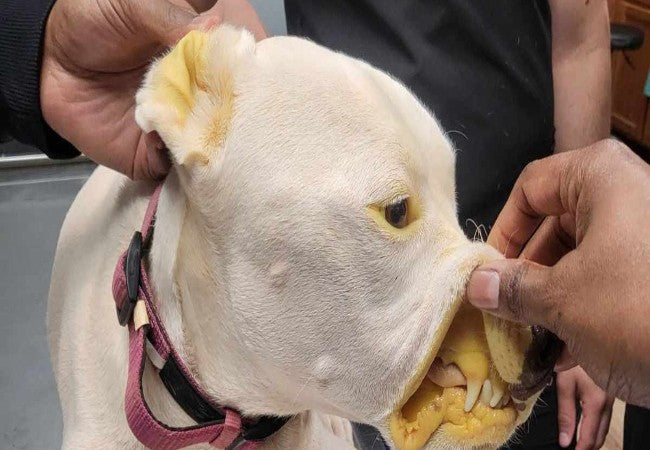Veterinary Guide to Canine Jaundice (Icterus) 2025 🐶

In this article
Veterinary Guide to Canine Jaundice (Icterus) 2025 🩺🐶
By Dr. Duncan Houston BVSc
🧬 What Is Jaundice?
Jaundice (or icterus) is the yellowing of a dog’s skin, eyes, gums, and mucous membranes due to excess bilirubin, an orange pigment formed during red blood cell breakdown. Visible when serum bilirubin exceeds ~35 µmol/L.
👥 Who Can Be Affected?
All ages, breeds, and sexes can develop jaundice. It’s a clinical sign, not a disease. Prompt veterinary attention is critical—it often signals an underlying emergency.
⚠️ Common Causes & Mechanisms
- Pre-hepatic (hemolysis): Increased RBC destruction (e.g., IMHA, tick-borne disease) overwhelms bilirubin removal.
- Hepatic (liver dysfunction): Infections, toxins, neoplasia, inherited liver shunts, or chronic hepatitis impair bilirubin conjugation.
- Post-hepatic (cholestasis): Obstruction of biliary excretion due to gallstones, mucocele, neoplasia or pancreatitis.
🌀 Clinical Signs Beyond Yellowing
- Yellow gums, whites of the eyes, skin, and ear flaps.
- Systemic signs: fever, vomiting, diarrhea, appetite loss, weight loss, lethargy.
- Increased thirst and urination, abdominal distension, pain, bruising, and bleeding disorders.
- Neurologic signs in liver failure (encephalopathy): seizures, head pressing, circling.
🔍 Diagnosing Jaundice
Diagnosis involves:
- History & exam: Check onset, environment, exposure, vaccination, and toxins.
- Bloodwork: CBC (anemia, reticulocytosis), chemistry panel (ALT, AST, ALP, GGT, total bilirubin), bile acids.
- Urinalysis: Bilirubinuria, assess hydration and renal function.
- Coagulation panel: PT/INR if liver synthetic function is compromised.
- Imaging: Ultrasound to evaluate liver architecture, gallbladder, biliary ducts; radiographs or CT as needed.
- Specific tests: Tick-borne panels, infectious disease titers, toxin screens.
- Liver biopsy or FNA: Definitive diagnosis for hepatic disease.
🛠️ Treatment Strategies
1. Address the Underlying Cause
- Hemolytic anemia: Immunosuppressive therapy (prednisone, azathioprine, cyclosporine), transfusions.
- Infections: Antibiotics for leptospirosis; antivirals or antifungals as needed.
- Biliary obstruction: Surgical intervention for gallstones, mucocele, and bile duct neoplasia.
- Liver disease: Hepatic diets (low protein, high carb), vitamin E, SAMe, silymarin, lactulose for encephalopathy.
2. Supportive Care
- IV fluids to restore hydration and support liver perfusion.
- Antiemetics, appetite stimulants, and pain management.
- Vitamin K supplementation in coagulopathy.
- Nutritional support: hepatic formulas, small, frequent meals.
3. Monitoring & Follow-Up
- Recheck bloodwork (bilirubin, liver enzymes) every 1–4 weeks early on.
- Follow-up ultrasound for hepatobiliary disorders or post-surgical changes.
- Monitor neurologic signs if encephalopathy is present.
📈 Prognosis & Outcomes
- Dependent on cause and severity. Acute hepatobiliary cases treated early can have good outcomes.
- Hemolytic anemia may be managed, but it may relapse.
- Chronic hepatic disease or neoplasia often has a guarded prognosis; long-term management may be needed.
- Obstructive biliary disease often needs surgery—prompt intervention improves survival.
🏡 Home Care & Prevention
- Follow the recommended hepatic or supportive diets exactly.
- Administer prescribed medications and supplements in full course.
- Maintain parasite control (ticks, leptospira) and avoid toxins.
- Regular veterinary rechecks, especially for dogs with chronic liver or hemolytic conditions.
📱 Ask A Vet Telehealth Support
- 📸 Upload photos of yellowed gums/eyes for expert remote triage.
- 🔔 Medication, feeding, and monitoring reminders.
- 🩺 Video consults to review symptoms like appetite, vomiting, thirst
🎓 Case Spotlight: “Bella” the Spaniel
Bella, a 6-year-old Cocker Spaniel, presented with yellow gums, vomiting, and lethargy. Diagnostics revealed elevated bilirubin, anemia, and positive leptospirosis titers. Hospitalized with IV fluids, doxycycline, antiemetics, and hepatic diet. Recovered over 10 days. Ask A Vet helped with daily photo checks, medication reminders, and delivered supplements. At 6-month recheck, labs normalized, and Bella is healthy again.
🔚 Key Takeaways
- Jaundice is a sign of elevated bilirubin, indicative of hemolysis, liver, or biliary disease.
- Always investigate promptly—it’s often a medical emergency.
- Diagnosis requires blood work, imaging, and sometimes a biopsy.
- Treatment targets cause plus supportive care; prognosis varies by etiology.
- Ask A Vet telehealth supports remote assessment, management, and follow-up care 📲🐾
Dr Duncan Houston BVSc, founder of Ask A Vet. Download the Ask A Vet app to support your dog through jaundice—from diagnosis and remote monitoring to med delivery and dietary coaching 🐶📲






